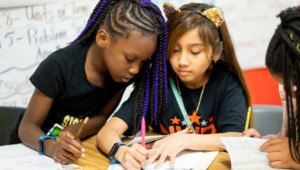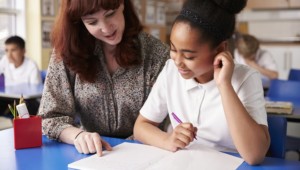Starting With the “Why” in Personalized Learning

By Betheny Gross
This post originally ran on the CRPE Blog, and is the fifth installment in a series of “Notes From the Field” on personalized learning.
Last spring, on our first visit to 35 schools committed to personalized learning, teachers often told us they weren’t sure what they were supposed to be doing to personalize learning. Revisiting the same schools this fall, we realized a more fundamental issue was at play: many teachers didn’t seem entirely sure why they were personalizing learning in the first place.
The teachers we interviewed certainly had clear goals for their students: to be ready for college and career, to be lifelong learners and successful adults. And most described the specific objectives for knowledge, skills, and attitudes their students would need to reach these goals. But only rarely could teachers tell us how the activities they do to personalize learning would deliver on these objectives. The problem is, without starting with that end in mind, it’s nearly impossible to build a coherent personalized learning (PL) approach.

In policy parlance, the teachers—and their schools—didn’t have a well-formed theory of action about PL. A theory of action explains how and why a certain intervention or approach is supposed to work. It helps get everyone on the same page about what they are doing and why. And it shapes the goals teachers and schools shoot for so they can see if their efforts are helping students achieve them. Operating without a well-articulated, well-understood theory of action leaves teachers sailing without a rudder and without a defined destination. And that can mean fuzzy or haphazard mix-and-match attempts at personalizing student learning—attempts that aren’t explicitly driven by what teachers want their students to know and be able to do when they leave school.
Take one PL goal: giving students the power to have more control over their learning, or “student agency.” A simple theory of action might look like this:

To support student agency, many teachers in the classrooms we visited had created “choice boards” to give students multiple options for engaging with a unit’s content. These choice boards can be incredibly time-consuming to create, take considerable effort to explain to students and be challenging to juggle once students get going. One middle school social studies classroom let students choose one of five characters (from architect to playwright) from history, each with its own route through the unit. While the students seemed to enjoy getting to choose a persona, many activities across the five routes were identical or similar (not personalized). But most importantly, this teacher—like many others we interviewed—seemed unsure of whether these choices were actually helping her students sharpen their decision-making skills, improve their engagement, or advance their confidence and ability to take responsibility for their own learning and lives—all goals the teacher had for her students.
To be sure, we catch pieces of the logic behind PL when talking with teachers. But more often we hear notes of frustration and confusion (and sheer exhaustion) as teachers try to redesign their classrooms and instructional approaches with little guidance beyond a broad directive to make these approaches more personal, tailored, and student-driven. Teachers are attracted to PL’s core ideas: meeting students where they are, letting students progress at their own rate, and offering students rich and relevant learning experiences, for example. But they appear to need more clarity not just in what they are doing but why they are doing it. Mapping the school’s theory of personalizing learning—and using it as a guide—could help. Here are a few ways to start this process:
- Start at the end and work backward. Schools should ask: What do we want students to be able to do when they leave the school? What learning experiences do they need to reach these goals? What do we need to do in classrooms and schoolwide to create those experiences? What support do teachers, principals, and other staff need to create such classrooms and experiences? Map out the answers to these questions and make them the basis of the school’s theory of action.
- Let the theory of action be a guide. Schools should share their theory of action with the community to help everyone understand it; help teachers, students, and parents own it; and reinforce the theory by constantly referring back to it.
- Reality-test the theory. A theory of action is an ideal vision of how something is supposed to work, not how it works in reality. Schools should ask: What assumptions does this theory make? (Are we assuming our staff will be stable enough to roll out the required professional development? Is this reasonable?) What needs to happen for us to just get to Step One? (Do we need to build capacity? Engage parents? Build students’ foundational skills?) Who beyond our own staff will need to help us succeed? (Does this plan rely on waivers to the contract from the teachers union? Are they willing and able to do so?) The answers will help schools and teachers identify what and who they need to support their PL initiative.
- Use the theory to evaluate progress and revise practice. By mapping the theory of action, the initial and final indicators that schools are working toward will become clear. Using the student agency example, an interim indicator might include some qualitative or quantitative account of data-focused discussions with students, or a student engagement survey to gauge the extent to which students feel they have agency in their work. A final indicator could be an assessment of students’ ability to stay on track and complete a long-term project.
Even for schools already knee-deep in PL, it’s never too late to step back and make sure everyone in the building understands why they are doing it.
For more on personalized learning, see:
- What Does Personalized Learning Mean for Teachers
- What Does Personalized Learning Mean for Students
- What Does Personalized Learning Look Like in Schools
Betheny Gross is a senior research analyst and research director at the Center on Reinventing Public Education (CRPE) at the University of Washington Bothell. Follow her on Twitter: @bethenygross.
Stay in-the-know with all things EdTech and innovations in learning by signing up to receive the weekly Smart Update.





0 Comments
Leave a Comment
Your email address will not be published. All fields are required.